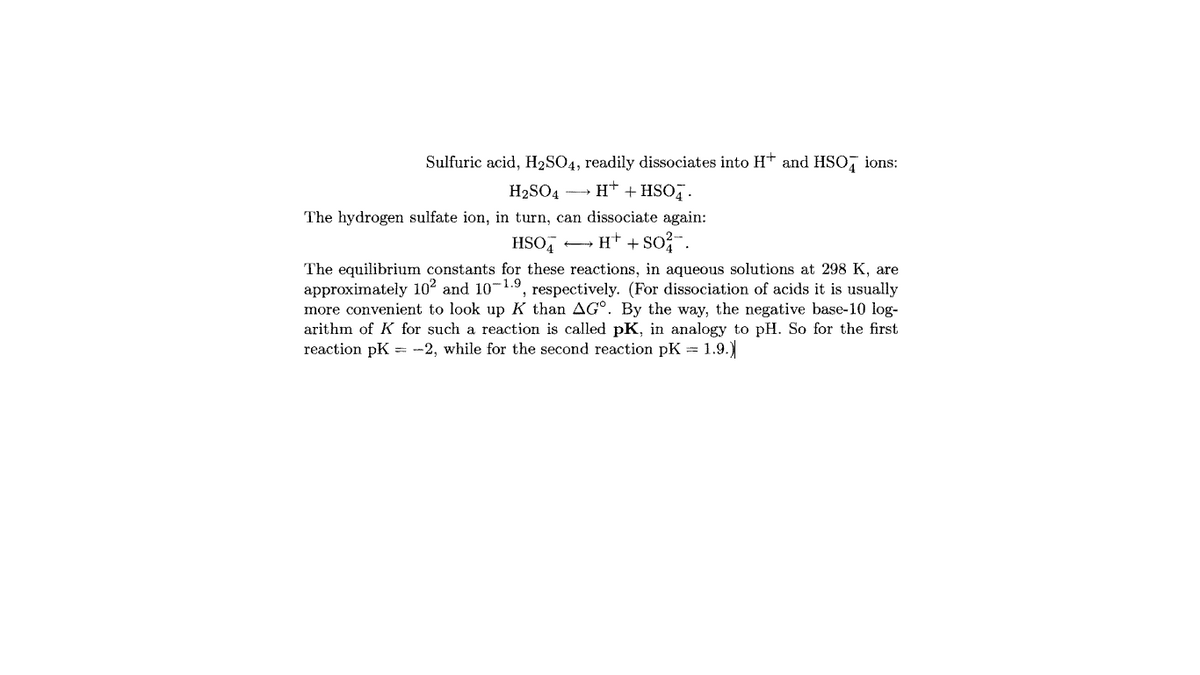Sulfuric acid, H2SO4, readily dissociates into H* and HSO, ions: H2SO4 H† + HSO7. The hydrogen sulfate ion, in turn, can dissociate again: HSO, H* + so?-. The equilibrium constants for these reactions, in aqueous solutions at 298 K, are approximately 102 and 10-1.9, respectively. (For dissociation of acids it is usually more convenient to look up K than AG°. By the way, the negative base-10 log- arithm of K for such a reaction is called pK, in analogy to pH. So for the first reaction pK = -2, while for the second reaction pK = 1.9.)
Sulfuric acid, H2SO4, readily dissociates into H* and HSO, ions: H2SO4 H† + HSO7. The hydrogen sulfate ion, in turn, can dissociate again: HSO, H* + so?-. The equilibrium constants for these reactions, in aqueous solutions at 298 K, are approximately 102 and 10-1.9, respectively. (For dissociation of acids it is usually more convenient to look up K than AG°. By the way, the negative base-10 log- arithm of K for such a reaction is called pK, in analogy to pH. So for the first reaction pK = -2, while for the second reaction pK = 1.9.)
Principles of Modern Chemistry
8th Edition
ISBN:9781305079113
Author:David W. Oxtoby, H. Pat Gillis, Laurie J. Butler
Publisher:David W. Oxtoby, H. Pat Gillis, Laurie J. Butler
Chapter16: Solubility And Precipitation Equilibria
Section: Chapter Questions
Problem 70AP
Related questions
Question
Argue that the first reaction tends so strongly to the right that we might as well consider it to have gone to completion, in any solution that could possibly be considered dilute. At what pH values would a significant fraction of the sulfuric acid not be dissociated?

Transcribed Image Text:Sulfuric acid, H2SO4, readily dissociates into H* and HSO, ions:
H2SO4 H† + HSO7.
The hydrogen sulfate ion, in turn, can dissociate again:
HSO,
H* + so?-.
The equilibrium constants for these reactions, in aqueous solutions at 298 K, are
approximately 102 and 10-1.9, respectively. (For dissociation of acids it is usually
more convenient to look up K than AG°. By the way, the negative base-10 log-
arithm of K for such a reaction is called pK, in analogy to pH. So for the first
reaction pK = -2, while for the second reaction pK = 1.9.)
Expert Solution
This question has been solved!
Explore an expertly crafted, step-by-step solution for a thorough understanding of key concepts.
This is a popular solution!
Trending now
This is a popular solution!
Step by step
Solved in 4 steps

Knowledge Booster
Learn more about
Need a deep-dive on the concept behind this application? Look no further. Learn more about this topic, chemistry and related others by exploring similar questions and additional content below.Recommended textbooks for you

Principles of Modern Chemistry
Chemistry
ISBN:
9781305079113
Author:
David W. Oxtoby, H. Pat Gillis, Laurie J. Butler
Publisher:
Cengage Learning


Chemistry by OpenStax (2015-05-04)
Chemistry
ISBN:
9781938168390
Author:
Klaus Theopold, Richard H Langley, Paul Flowers, William R. Robinson, Mark Blaser
Publisher:
OpenStax

Principles of Modern Chemistry
Chemistry
ISBN:
9781305079113
Author:
David W. Oxtoby, H. Pat Gillis, Laurie J. Butler
Publisher:
Cengage Learning


Chemistry by OpenStax (2015-05-04)
Chemistry
ISBN:
9781938168390
Author:
Klaus Theopold, Richard H Langley, Paul Flowers, William R. Robinson, Mark Blaser
Publisher:
OpenStax